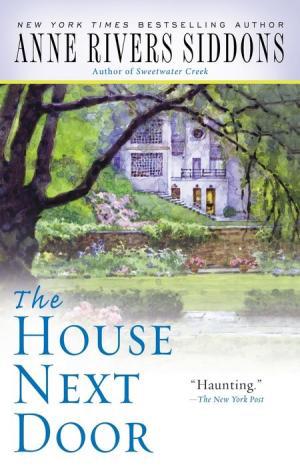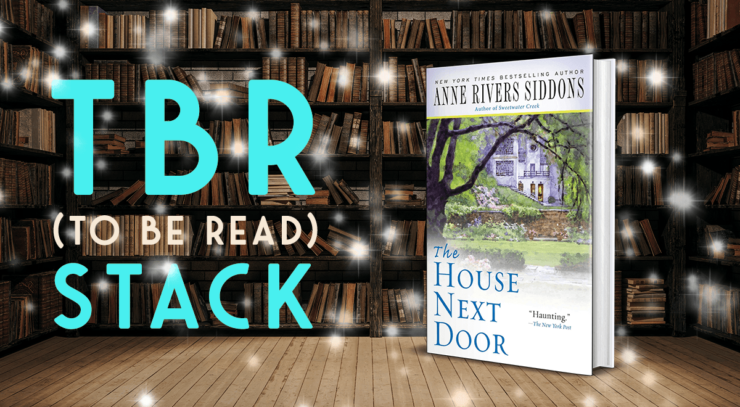When I’m reading a book here are two things I love above all else: stories that aren’t afraid to follow their own weird paths, and stories that dig into class. I’m ecstatic to report that The House Next Door does both of those things! And it’s scary!
Last month my beloved colleague Molly Templeton talked about Summer Reading Assignments in her column, Mark as Read. For once I’ve given myself a summer reading goal: I’m trying to work through as many haunted house books as I can fit into my eyeballs before Spooky Season. First up is Anne Rivers Siddons’ modern classic The House Next Door, a book I’ve been meaning to read for years.
The premise is deceptively simple: Colquitt Kennedy and her husband, Walter, live in a nice neighborhood in a Southern city. For years the lot next door has been empty. The parcel was carved into such an odd shape by earlier developers that no one thought they could build a house on it, and it’s been left as a verdant jungle that gives the Kennedys some space, and creates a lovely bucolic atmosphere for their home. Naturally, they’re upset when they learn that a hotshot young architect has figured out a way to work with the land, and they’ll have a new house and new neighbors practically right on top of them. But the house does go up, and that’s when things start to fall apart.
Siddons creates an incredibly precise social circle and point in time. Colquitt opens with the line: “People like us don’t appear in People magazine” and then goes on to summarize her life with her husband, their careers (he’s in advertising, she’s in PR), their trappings (“Walter has the obligatory tobacco-brown Mercedes sedan, and I have the obligatory compact station wagon”; they collect antiques; they’re building a rock garden), and, finally, explain why she and her husband are in the pages of the latest glossy People.
Buy the Book


The House Next Door
She and Walter gave an interview to let everyone know the house next door is haunted—before its next victim moves in.
This is one hell of an opening. As much as I’m in love with the perfect first page of Haunting of Hill House, this sucker pulls you in with a slow build of detail and normalcy that forces you to keep reading just so you can figure out when it’s going to turn into a horror novel. And then when it does it’s delightful, if you like that sort of thing. (I read this while I was staying in a [significantly less haunted] house with friends, and they commented more than once on my giggles of joy each time another character came to a tragic end.) And from there, Siddons immerses us in the life of Colquitt Kennedy and her social circle. All of them are upper middle class, and they live their lives ping-ponging between glamorous jobs, tennis matches, lunches at the club, and dinner parties with each other. They’re all liberal in that post-Lyndon Johnson, New South way—they scoff at racism, serve on boards, support charities, and fund programs to help “underprivileged” neighborhoods, but, well, I’m not sure how it would go if anyone from those underprivileged neighborhoods actually moved in next door. It’s the waning days of the 1970s, so the characters are just Old South enough that their gardens need to be magazine-worthy, and they’re all equal parts scandalized and thrilled that a “modern” house is being built on the last empty lot in the neighborhood.
Now, when I say it gets weird, what I mean is that it fully commits to its time and place. Colquitt talks about her set like they’re normal, like any reader will understand archetypes like Virginia Guthrie, the proper Southern lady who shows no emotion but is the most loyal friend you’ll ever have, and Pie Harralson, the newlywed former cheerleader whose every waking moment is spent in calculated revenge against her Daddy. She expects you to understand the references to different neighborhoods, the Junior League, the club, the various sports events that shape the men’s lives.
Colquitt is a perfect narrator, warm and chatty, slightly gossipy but not mean, and just comfortable enough in her own life that she doesn’t notice things getting weird until it’s too late. This is perfect for this novel, as so many of early haunting incidents seem “tragic-but-mundane” rather than “a ghost did this”, so the reader gets to slowly come to the truth as Colquitt’s own rational explanations start to fall apart. Her slight snobbishness also helps with this, as she spends the first part of the book swerving between being judgey toward each new set of neighbors, and trying hard to be a good, friendly Southern woman.
There’s also the fact that…this might be a cultural thing, but Colquitt and Walter are lushes. (And I say this as a dedicated lush.) I don’t think I’ve read a non-Fitzgerald book that featured so many pitchers of martinis or bottles of wine or tumblers of whiskey gulped in a panic. If you squeezed this book gin would drip from the pages. And some of this, again, is Siddons’ building a picture of upper-crust Southerners who lubricate all of their social interactions, but I also think it adds up to an interesting drumbeat of untrustworthy narration. If you want to fall on the side of “the house isn’t haunted, Walter and Colquitt are imagining it” the fact that they’re always a little tipsy certainly helps.
Siddons trusts her reader not only to follow Colquitt through her social seasons, but also to allow the book to focus on quiet, domestic life for chapter after chapter. We get blow-by-blow descriptions of the construction of the house. We watch Colquitt gradually build an intense friendship with the architect, Kim Dougherty—a friendship that, at times, scandalizes the neighbors. We hear about Colquitt’s clients, about a trip to their summer place in South Carolina, about a fun week in New York. And for a horror novel I think this counts as weird. There are enormous swathes of this book that, if I sliced them out and handed them to you, you’d think you were reading an upscale domestic story, where maybe there’d be a mid-life crisis, some light embezzlement, or someone would cheat with a secretary—or, at most, there’d be a murder and a rumpled detective would show up to ask a few questions—but you’d never suspect that anything supernatural was happening. This is the book’s greatest strength. We’re so enmeshed in the life of this street and its unusually tight-knit neighbors that when the horror does start to hit it feels shocking and uncanny. Like you expect Hill House to have something up its sleeve. You know some terrible shit went down in Hell House—it’s fucking called “Hell House”! But this brand-new, ultramodern, gleaming construction, with the newlyweds and the baby bump and the puppy? How can anything bad happen here?
Siddons’ descriptions of the house are a masterstroke in that I’m still not sure quite what it looks like, but I know exactly what it feels like. When I try to picture it, I see green light washing in through the trees that surround the house, plush white carpet, chrome furniture, a sweeping front staircase, walls of glass rather than windows. Essentially, it feels like a sleek early-‘80s house appearing in a neighborhood that was built under the influence of Gone With the Wind. And the other perfect choice is that we never spend so much as a single night in the haunted house. We’re in Colquitt’s POV the entire time, so we stop in for a few parties, peek in the windows—but for most of the book we observe the haunting from next door, in growing terror, helpless to do anything to stem the evil.
And the evil itself? Reveals itself in small, mundane ways that gradually build into domestic tragedy, again and again, cycles that exploit all the fault lines of each successive family. Without spoiling anything, the evil that lurks makes the house feel like a dream home to each new prospective owner, then digs into their minds to find the habits and desires that will explode their lives.
I think also the fact that it’s a new house adds to the creepiness of the book. So often a haunted house story opens with a person coming to a foreboding mansion, or moving into A Place With A Dark Past, but here we watch the house being built. We get to know the architect, a charming young man who makes winking references to The Fountainhead and plays the part of a genius to impress clients. And then we meet the families who move in. You could say that they bring the horror with them, and I think part of Siddons’ purpose with the book is to show how “wherever you go, there you are”—moving to a new house won’t erase the grief of losing a child, or solve the internalized self-hatred that’s tearing your husband apart. You’re still YOU, once all the boxes are unpacked and the nice folks next door have invited you to your first neighborhood dinner party.
But personally I’m on #TeamTheHouseIsHaunted. The horror is inexplicable. I don’t want to spoil it, but as the horror grows gradually over the course of the book, Siddons never overplays her hand, or tips into any Scooby-Doo-esque explanations of why these terrible things are happening. The world is utterly realistic until it utterly isn’t. And even when Siddons reveals a possible source of the horror, she still maintains an air of mystery around it. We might know how, but we still don’t know how, so there isn’t any of that “Oh, the house was built on a graveyard” let-down that sometimes comes at the end of a horror tale. Instead the creepiness stays with you, because this is the kind of haunting that could happen to any house, in any town, at any time.










